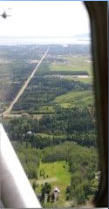

3) Filing a Flight Plan
"Filing a flight plan" means contacting Flight Services, either by phone or radio (nowadays can also be done online),
to give them the details of your planned flight. This is required when you are going further than 25 nautical miles out
from your point of departure. There are codes and protocols to follow, set out by Nav Canada and Transport Canada,
and which may vary depending on Visual or Instrument Flight Rules.
Basically, Werner needs to tell them:
•
he’s flying VFR (= Visual Flight Rules, i.e. we need 3-mile visibility, and cloud cover may be no lower than 1000 ft.)
•
the airplane’s ”call sign” (registration or identification letters) is CF-FZO
•
CF-FZO is a Cessna 150 equipped with VHF radio communication equipment, plus a transponder
•
(having checked wind conditions, etc.) he expects to fly x nautical miles per hour, or knots (”true airspeed”)
•
the airport he’s leaving from, using the airport’s letter code (e.g. CYKF = Waterloo Regional Airport)
•
how high he plans to fly, measured in feet above sea level (ASL) (There are airspace rules about what
altitudes to use to keep vertical space between aircraft, depending on the direction you’re flying,
although not as stringent for VFR traffic).
•
the route he’s planning to take (e.g. direct to destination, or via some other place before landing), and
the airport where he plans to land
•
the time he’ll depart, given in Co-ordinated Universal Time (UTC)
•
how long he estimates the flight should take (hours and minutes)
•
that he has three hours and forty-five minutes worth of fuel on board (There needs to be enough fuel
for 30-45 minutes of extra flight for emergencies, so our flights on full tanks may not surpass 3 hours).
•
that he has an AP ELT on board (Automatic Portable - Emergency Locator Transmitter)
•
there are two people on board (himself and me)
•
his name and address as pilot and aircraft owner, and his pilot’s license number
•
the airplane is silver with black markings, and on wheels (i.e. not floats or skis)
•
that he will phone in (or he could choose radio in) to notify when he has arrived at destination
o
(If you don't let them know you’ve arrived, Search and Rescue (SAR) will automatically start looking for you
one hour after you were expected--a good thing! However, if non-notification is just an oversight on your part,
SAR will not be amused...)


Waterloo to Calgary in a Cessna 150






Important notice: All images and text on this website ©whphotoplus. All rights reserved. You view this website at your own risk.
External links are provided for information only; each opens in a new window. We take no responsibility for their content or your usage of those websites.


Extra! Pilot Stuff


